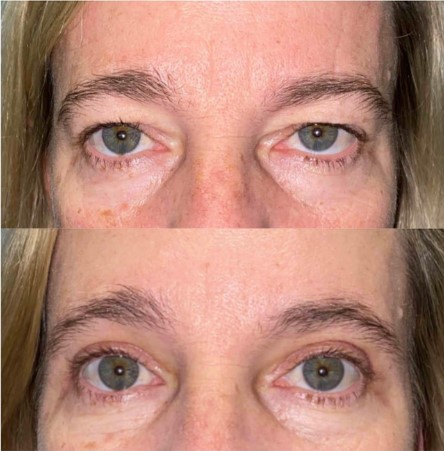upper eyelid blepharoplasty
What is an upper eyelid blepharoplasty?
An upper eyelid blepharoplasty, commonly known as an eye lift, is a surgery done to remove excess skin and puffy fat on the upper eyelid area. A blepharoplasty can be done for cosmetic reasons to provide a more youthful and rested appearance. When the eyelid heaviness is severe and obstructing vision, a blepharoplasty can also be performed for medical reasons to improve vision.
What is the Process Like for an Upper Eyelid Blepharoplasty?
Before the surgery, your oculofacial plastic surgeon will assess your condition and develop an individualized treatment plan for your particular case. Your surgeon may recommend that you undergo other surgeries, like a brow lift or lower eyelid blepharoplasty, in conjunction with your upper eyelid blepharoplasty to achieve optimal results. If your surgeon finds any issues that could affect the final result of the surgery such as thyroid eye disease, skin cancer, eyelid laxity, and/or dry eye; it is recommended that these problems are attended to before the procedure.
During the surgery, your surgeon will create an incision in your eyelid crease, remove the extra skin, and then remove or re-contour the upper eyelid fat (if necessary).
Small sutures will then be used to close the incision line. Although this procedure may commonly be known as an “eyelid lift” or “eyelid tuck”, know that the eyelid itself may not be actually lifted during the procedure. However, the heaviness of the tissue on the upper eyelids will be improved. If the heaviness of the tissue was blocking your vision, the peripheral and upper central vision is often improved after surgery as well.
Aftercare for upper eyelid blepharoplasty surgery will be provided to you by your surgeon. However, common post-operative instructions include:
- Ice or compression goggles to reduce bruising and swelling.
- Antibiotic ointment to prevent infection.
- Avoiding all strenuous activity to reduce the risk of bleeding and swelling (slow walking that does not elevate your heart rate or blood pressure is ok).
- Sleeping with your head elevated and wearing eye protection at night for two weeks to avoid breaking the delicate incision line.
When Should I Consider an Upper Eyelid Blepharoplasty?
As you age, the skin and muscles of your eyelids may begin to thin, sag and/or droop. The skin loses its elasticity and extra folds of skin may become apparent. Your upper eyelids may become more puffy or heavy as the normal fat around your eye begins to bulge from under the skin. Genetics, diet, other health factors, and sun exposure also contribute to the thinning and muscle weakening process.
You should consider undergoing an upper eyelid blepharoplasty if:
- You look in the mirror and are not happy with the current appearance of your eyelids
- Your eyes look heavy all the time
- You have noticed that the skin on your eyelids have begun to sag or droop downwards
- Your eyes are consistently puffy, no matter how much rest you get
- People tell you that you look tired all of the time
- You have trouble using your peripheral vision
- You have trouble using your upper central vision
If you experience any of these aforementioned issues, consider contacting us to set up a consultation with one of our board-certified oculofacial plastic surgeons.
For more information on post-operative care, click here. The content on this page is generalized information and is not medical advice. You will receive your own customized instructions from our providers.
For before and after pictures of our upper eyelid blepharoplasty procedure, click here.
Dr. Nicole Langelier

Upper Eyelid Blepharoplasty
Dr. William Bearden

Upper Eyelid Blepharoplasty
Dr. Nicole Langelier

Upper Eyelid Blepharoplasty
Gallery |
